The global piston seals market is projected to reach USD 3.63 billion by 2035, up from USD 2.5 billion in 2025, expanding at a CAGR of 3.8%. The United States and China remain key growth drivers, supported by industrial automation, renewable energy, and smart hydraulic systems.
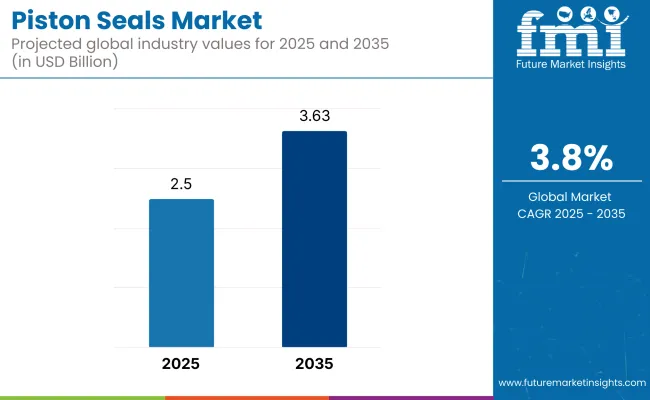
Germany, India, and South Korea are emerging as innovation and manufacturing hubs. Double-acting rod seals dominate revenue share due to their versatile use in high-pressure, bidirectional applications, while custom-designed hydraulic seals are gaining rapid traction in precision engineering and EV applications.
Growth is largely driven by rising demand for durable, low-friction, and intelligent sealing systems across automotive, aerospace, and heavy machinery sectors. Environmental concerns are pushing the adoption of biodegradable and self-lubricating materials, particularly in Europe.
Additionally, the rise of electric vehicles is prompting the need for advanced polymer- and PTFE-based seals that offer better wear resistance and thermal stability. However, high raw material costs and complex regulatory frameworks remain key barriers to scalability.
Looking ahead, the integration of IoT sensors, 3D printing of custom seals, and use of recyclable thermoplastics will transform the market. Western manufacturers are focusing on smart predictive maintenance seals, while Asia is investing in compact, cost-effective designs.
Strategic investments in automation, green material R&D, and localized production facilities will define competitive advantage. Global leaders like Parker Hannifin, Trelleborg, and Freudenberg are spearheading innovations to cater to region-specific performance needs and regulatory standards.
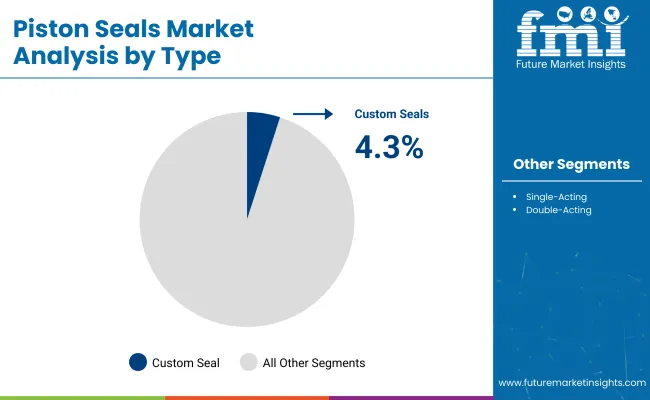
Custom-designed hydraulic seals are the fastest-growing category, driven by increasing demand for niche, application-specific solutions in sectors like robotics, EVs, and smart manufacturing. While double-acting rod seals currently dominate due to their bi-directional functionality in high-pressure systems, custom variants are gaining ground due to enhanced material tolerance, temperature stability, and sealing precision.
These seals are being extensively adopted in renewable energy, aerospace, and advanced manufacturing facilities that require exacting standards. Single-acting seals remain essential but lack the customization advantages driving new demand.
| Type Segment | CAGR (2025 to 2035) |
|---|---|
| Custom Hydraulic Seals | 4.3% |
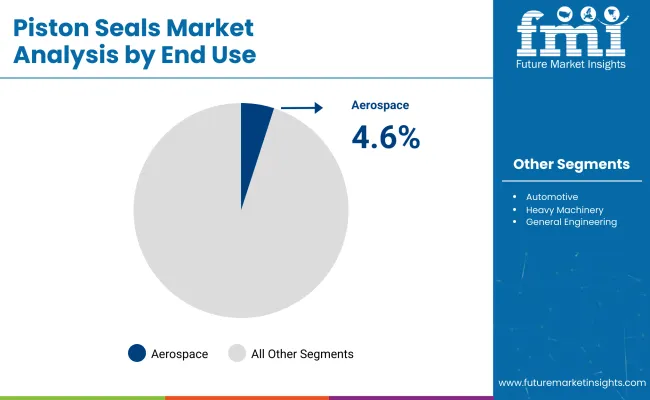
| End Use Segment | CAGR (2025 to 2035) |
|---|---|
| Aerospace | 4.6% |
The aerospace sector is poised for the fastest CAGR through 2035, surpassing traditional automotive applications. High-reliability seals are required in aircraft landing gear, actuators, and hydraulic systems-pushing demand for PTFE-based and high-performance elastomer seals.
As space exploration and commercial aviation rebound, manufacturers are moving toward lighter, compact, and low-friction sealing systems. Meanwhile, automotive remains the largest end-use segment, driven by ICE and EV transitions, while heavy machinery and general engineering maintain steady demand for wear-resistant solutions.
Regional Difference
Spread of High Adoption Rates
ROI Perceptions
Automation and smart seals were preferred by 72% of USA stakeholders as “worth the investment,” while 38% of Japanese respondents preferred manual wear monitoring of the seals.
Consensus
Polyurethane and PTFE-based seals gained acceptance by 64% across the globe for their chemical resistance and longer wear life.
Regional Discrepancies
Common Concerns
84% reported rising raw material and energy prices as major catalysts influencing pricing.
Regional Price Sensitivity
Manufacturers
Distributors
Industrial Operators
Alignment
70% of global manufacturers plan to invest in future-proof sealing technologies, particularly to enable predictive maintenance.
Regional Differences
Global Agreements
Safety, durability, and cost considerations are also issues of global relevance;
Key Industry Differences
Strategic Insights
To achieve maximum industry penetration and profitability, firms must tailor product offerings to regional functional needs-intelligent seals for the United States, green solutions for Europe, and low-cost, space-saving designs for Asia.
| Countries | Government Regulations & Mandatory Certifications |
|---|---|
| United States |
|
| United Kingdom |
|
| France |
|
| Germany |
|
| Italy |
|
| South Korea |
|
| Japan |
|
| China |
|
| Australia & NZ |
|
| India |
|
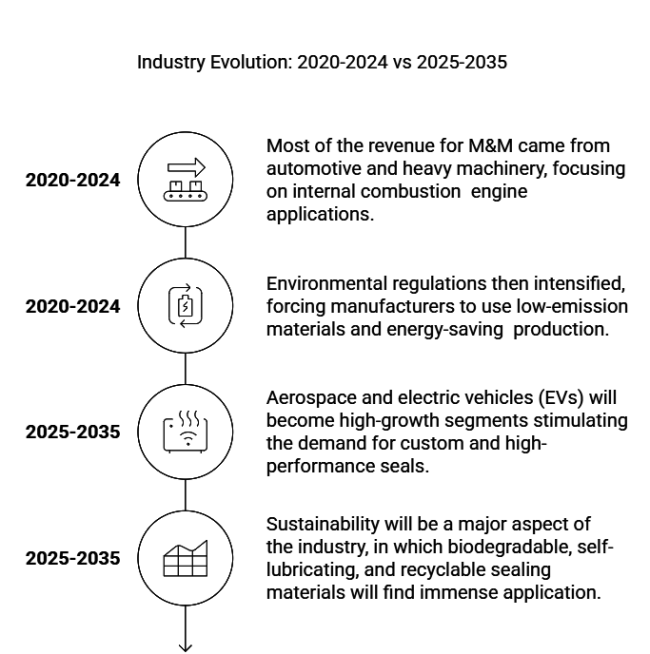
| 2020 to 2024 | 2025 to 2035 |
|---|---|
| The industry expanded moderately, driven by a recovery from COVID-19 disruptions and increased industrial activity. | The industry will continue to grow steadily, powered by automation, sustainability, and technological innovation in materials. |
| Manufacturing and distribution were hampered by shortages of raw materials and disruptions in the supply chain. | Supply chain resilience and localization initiatives will lessen dependence on mercurial imports. |
| Most of the revenue for M&M came from automotive and heavy machinery, focusing on internal combustion engine applications. | Aerospace and electric vehicles (EVs) will become high-growth segments stimulating the demand for custom and high-performance seals. |
| Traditional hydraulic and pneumatic seals dominated the industry, with little adoption of smart sealing solutions. | The adoption of IoT-enabled smart piston seals is expected to grow in Industry 4.0 applications and predictive maintenance scenarios. |
| Environmental regulations then intensified, forcing manufacturers to use low-emission materials and energy-saving production. | Sustainability will be a major aspect of the industry, in which biodegradable, self-lubricating, and recyclable sealing materials will find immense application. |
| Ongoing demand increases in China, North America, and Europe, driven by strong industrial growth in these regions. | Industry growth in the Asia-Pacific region, especially in India and Southeast Asia, will occur at a faster rate due to high industrialization and investment in infrastructures. |
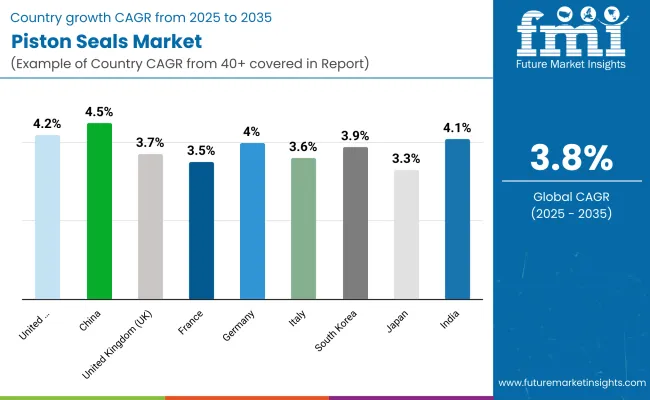
The USA piston seals industry is set to grow at a CAGR of 4.2% between 2025 and 2035, owing to industrial automation, smart manufacturing expansion, and high safety standards. The country is a pioneer in adopting IoT-powered sealing solutions as the automotive, aerospace, and oil & gas sectors drive the demand for high-performance, low-maintenance seals.
These are OSHA and ANSI standards that greatly affect the safety and quality of the highest standard. Enhancing hydraulic, pneumatic defense, and renewable energy systems due to further investments will spur demand for rod seals with a high degree of robustness as well.
The United Kingdom has set a target for the piston seals industry to record a CAGR of 3.7% in the 2025 to 2035 period, based on post-Brexit commerce policies, the popularity of metallic sustainability applications, and extensive automation intelligence in various industries.
The movement from CE marking to UKCA certification increased compliance costs, modestly dampening industry growth. Yet stringent environmental regulations have brought a demand for sustainable and energy-saving seals. The construction, manufacturing, and oil & gas industries that require durable and weather-resistant hydraulic seals to meet the UK Health and Safety Executive (HSE) standards also drive industry growth.
Automobile & Industrial Automation Technologies anticipates 3.5% CAGR growth for the French piston seals industry by 2025 to 2035. The country is a major automotive and aerospace manufacturing hub, demanding innovative sealing solutions.
It is in this ICPE (Installations Classified for Environmental Protection) context, with grave environmental and material constraints, that this study should be carried out to push companies to use low-friction and recyclable materials. In addition, the EU's emphasis on emissions reduction and energy efficiency will also increase the need for low-maintenance and self-lubricating cylinder seals in hydraulic and pneumatic systems.
With robust industrial and automotive industries, the German piston seals industry is projected to grow at a CAGR of 4.0% during 2025 to 2035. It has one of the strictest regulatory environments and requires TÜV, DIN, and CE certifying standards for seal performance and quality.
Germany's leadership in Industry 4.0 has driven increased adoption of smart hydraulic systems with predictive maintenance technologies. With Germany’s ambitious sustainability initiatives, energy-efficient sealing solutions are also on the rise. High-durability seals are also crucial to support growth where machinery, aerospace, and renewable energy industries are concerned.
Rising manufacturing, automotive, and construction sectors are expected to propel the Italian piston seals industry at a CAGR of 3.6% during the forecast period (2025 to 2035). Italy is implementing the EU CE marking regulations. The source of this information is unclear and seems to be a typographical error.
The Ministry for Ecological Transition had been encouraging manufacturers to use sustainable and recyclable sealing products. The demand for highly accurate, wear-resistant seals is growing in hydraulic systems used in heavy machinery and automation. Due to the industrial strength of the Italian industry, particularly in textiles, food processing, and automobile manufacturing, the requirement for rugged rod seals in the country is always increasing.
The South Korea piston seals industry is expected to have a CAGR of 3.9% for the forecast period between 2025 and 2035 as a result of technological innovation in semiconductor production, intelligent factories, and robotics. The significance of high-performance and compact-sized hydraulic seals has grown in response to high-tech industrial automation in South Korea. KC certification ensures that the seals meet the safety and durability standards.
Additionally, the South Korean government's push for eco-friendly manufacturing is driving innovative energy-saving and low-emission sealing technology. Forceful growth in expansions is particularly seen in electronics, shipbuilding, and heavy machinery applications, where a broad range of highly specialized hydraulic seals are in widespread use.
Slow adoption of intelligent sealing technologies in Japan, due to a preference for traditional, high-precision components, is expected to moderate industry growth, resulting in a 3.3% CAGR from 2025 to 2035. The regulations of JIS and METI emphasize the quality of materials and performance consistency.
While Japan has a strong industrial base, companies gravitate to analogue solutions that are cheap and reliable rather than automation. The automotive, precision machinery, and heavy engineering sectors consistently expand, but their slower adoption of IoT-enabled seals compared to the USA and Europe hinders faster industry growth.
The piston seals industry in China is anticipated to grow at a CAGR of 4.5% during 2025 to 2035, making it one of the fastest-growing industries, followed closely by India at 4.1%. The demand is high due to industrialization, infrastructure development, and the manufacturing dominance of the country. CCC (China Compulsory Certification) and GB Standards regulate sealing solutions for safety and quality.
Growing demand for high-performance hydraulic and pneumatic seals is being spurred by the growth of electric vehicles (EVs) and renewable energy projects. With the push by China’s government for automation, intelligent manufacturing, and green energy programs, there is an increasing use of long-lasting, high-performance cylinder seals.
Between 2025 and 2035, the hydraulic rod seals industry in India is expected to grow at a CAGR of 4.1%, owing to fast-paced industrialization, infrastructure growth, and robust automotive growth. The Bureau of Indian Standards (BIS) and ISI certifications control the quality of products.
India's Make in India program has strengthened domestic production for hydraulic and pneumatic seals, reducing imports. The government's smart city, electric vehicles, and industrial automation initiative are also fuelling demand for high-durability, low-cost sealing solutions. There is a particular need for reliable sealing solutions in construction equipment, aerospace, and energy applications.
These companies compete with each other with respect to the pricing strategies, technological innovation, strategic partnerships, and expansion of their business horizons. Industry leaders focus on high-performance, premium seals for aerospace and electric vehicles, while others pursue cost-sensitive industries with commoditized solutions. Material innovation in terms of self-lubricating and high-temperature-resistant materials is a differentiator, with key companies investing in R&D for IoT-enabled smart seals.
Firms are also building more industrial bases in Asia and North America to localize production and reduce supply chain risks. Industry presence is strengthened through OEM and distributor partnerships, while technological innovation and regional expansion are driven by mergers and acquisitions (M&As).
The industry is segmented into double-acting, single-acting and custom designed
It is segmented into automotive, heavy machinery, general engineering and aerospace
It is fragmented into North America, Latin America, Europe, Asia Pacific, Middle East and Africa
Industries like automotive, aerospace, heavy machinery, and industrial automation rely on them for fluid control/sealing performance.
New IoT-enabled seals with real-time monitoring and predictive maintenance capabilities are being adopted, boosting performance and minimizing downtime.
Self-lubricating polymers, corrosion-free composites, and bio-based elastomers are leading innovation in durability and sustainability.
North America and Europe are dominating the high-performance, eco-tenable seals, whereas Asia-Pacific is developing quickly owing to the growing industries and infrastructure companies.
Production has become exceptionally complex due to raw material price volatility, stringent regulatory requirements, and customization needs.






Full Research Suite comprises of:
Market outlook & trends analysis
Interviews & case studies
Strategic recommendations
Vendor profiles & capabilities analysis
5-year forecasts
8 regions and 60+ country-level data splits
Market segment data splits
12 months of continuous data updates
DELIVERED AS:
PDF EXCEL ONLINE
Piston Grouting Pump Market Size and Share Forecast Outlook 2025 to 2035
Piston Fillers Market Size and Share Forecast Outlook 2025 to 2035
Axial Piston Motor Market- Analysis and Forecast by Product Type, End-User and Region 2025 to 2035
Axial Piston Pumps Market
Engine Piston Ring Set Market Size and Share Forecast Outlook 2025 to 2035
Radial Piston Motor Market Size, Share, and Forecast 2025 to 2035
Radial Piston Pumps Market
Automotive Piston System Market Growth - Trends & Forecast 2025 to 2035
Lightweight Aluminium Pistons Market Growth - Trends & Forecast 2025 to 2035
Polymer Seals Market Growth – Trends & Forecast 2025 to 2035
Padlock Seals Market
Aircraft Seals Market Size and Share Forecast Outlook 2025 to 2035
Automotive Seals and Gaskets Market Size and Share Forecast Outlook 2025 to 2035
Mechanical Seals Market Growth - Trends & Forecast 2025 to 2035
Indicative Seals Market
Fixed Length Seals Market Size and Share Forecast Outlook 2025 to 2035
Rotating Shaft Seals Market Size and Share Forecast Outlook 2025 to 2035
Food Processing Seals Market Growth & Demand, 2025 to 2035
IV Infusion Bottle Seals & Caps Market Size and Share Forecast Outlook 2025 to 2035
Examining Market Share Trends in IV Infusion Bottle Seals & Caps

Thank you!
You will receive an email from our Business Development Manager. Please be sure to check your SPAM/JUNK folder too.
Chat With
MaRIA